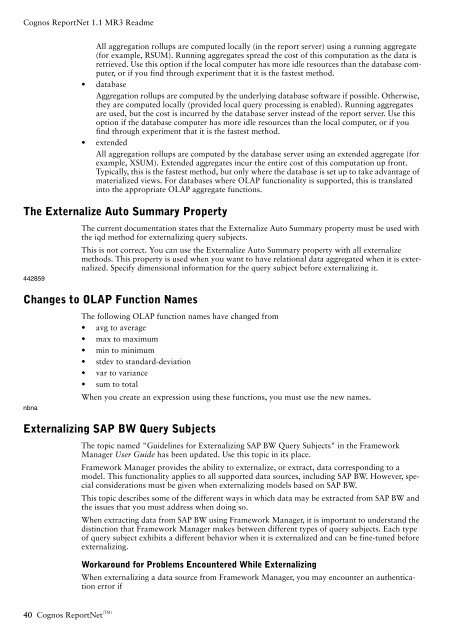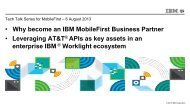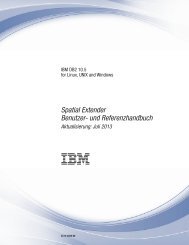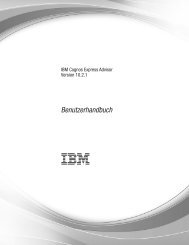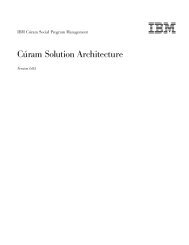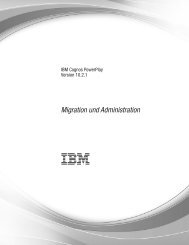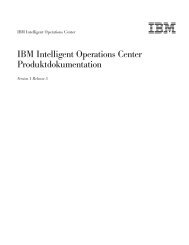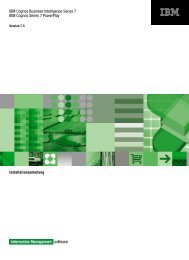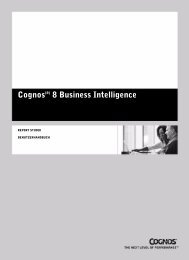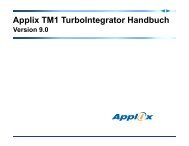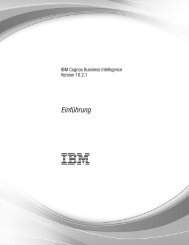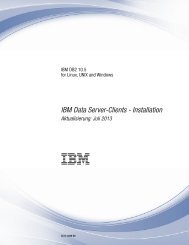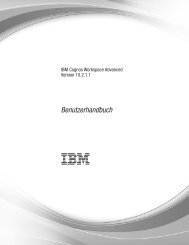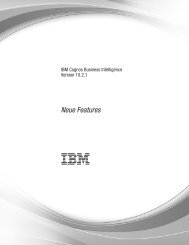Erfolgreiche ePaper selbst erstellen
Machen Sie aus Ihren PDF Publikationen ein blätterbares Flipbook mit unserer einzigartigen Google optimierten e-Paper Software.
<strong>Cognos</strong> <strong>ReportNet</strong> 1.1 MR3 <strong>Readme</strong><br />
All aggregation rollups are computed locally (in the report server) using a running aggregate<br />
(for example, RSUM). Running aggregates spread the cost of this computation as the data is<br />
retrieved. Use this option if the local computer has more idle resources than the database computer,<br />
or if you find through experiment that it is the fastest method.<br />
• database<br />
Aggregation rollups are computed by the underlying database software if possible. Otherwise,<br />
they are computed locally (provided local query processing is enabled). Running aggregates<br />
are used, but the cost is incurred by the database server instead of the report server. Use this<br />
option if the database computer has more idle resources than the local computer, or if you<br />
find through experiment that it is the fastest method.<br />
• extended<br />
All aggregation rollups are computed by the database server using an extended aggregate (for<br />
example, XSUM). Extended aggregates incur the entire cost of this computation up front.<br />
Typically, this is the fastest method, but only where the database is set up to take advantage of<br />
materialized views. For databases where OLAP functionality is supported, this is translated<br />
into the appropriate OLAP aggregate functions.<br />
The Externalize Auto Summary Property<br />
442859<br />
The current documentation states that the Externalize Auto Summary property must be used with<br />
the iqd method for externalizing query subjects.<br />
This is not correct. You can use the Externalize Auto Summary property with all externalize<br />
methods. This property is used when you want to have relational data aggregated when it is externalized.<br />
Specify dimensional information for the query subject before externalizing it.<br />
Changes to OLAP Function Names<br />
nbna<br />
The following OLAP function names have changed from<br />
• avg to average<br />
• max to maximum<br />
• min to minimum<br />
• stdev to standard-deviation<br />
• var to variance<br />
• sum to total<br />
When you create an expression using these functions, you must use the new names.<br />
Externalizing SAP BW Query Subjects<br />
The topic named "Guidelines for Externalizing SAP BW Query Subjects" in the Framework<br />
Manager User Guide has been updated. Use this topic in its place.<br />
Framework Manager provides the ability to externalize, or extract, data corresponding to a<br />
model. This functionality applies to all supported data sources, including SAP BW. However, special<br />
considerations must be given when externalizing models based on SAP BW.<br />
This topic describes some of the different ways in which data may be extracted from SAP BW and<br />
the issues that you must address when doing so.<br />
When extracting data from SAP BW using Framework Manager, it is important to understand the<br />
distinction that Framework Manager makes between different types of query subjects. Each type<br />
of query subject exhibits a different behavior when it is externalized and can be fine-tuned before<br />
externalizing.<br />
Workaround for Problems Encountered While Externalizing<br />
When externalizing a data source from Framework Manager, you may encounter an authentication<br />
error if<br />
40 <strong>Cognos</strong> <strong>ReportNet</strong> (<strong>TM</strong>)


